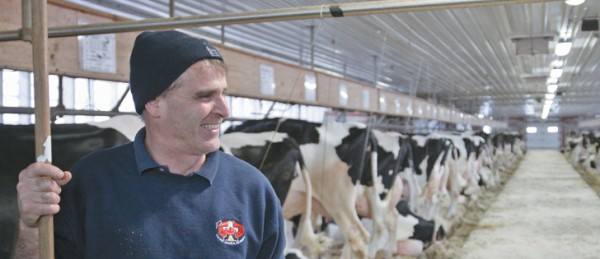Thierry Jaton’s family looked for the cheapest land possible to buy when they moved from Switzerland to Quebec 34 years ago.
What they found was a dairy farm with an old barn, fields full of stones, old machinery, no artificial insemination or dairy testing program and a barn full of grade cows.
They bought it.
“It was a way to have something,” Jaton said during a tour of his award winning Holstein farm organized by the Canadian Forage and Grasslands Association.
“The only way to have something is to work hard, and we work hard,” he said.
The owners included Jaton’s wife, parents and aunt and uncle. His parents are retired, but his uncle, 66, is still milking cows every day.
The hallway into the barn sports rows of awards, certificates, banners and photographs of the farm’s purebred Holstein herd.
“We love the cows.”
The Jatons milk 110 of their 290 cows. Of those, 17 are rated excellent, 74 very good and 34 good plus. The classification system is based on the animals’ physical conformation compared to breed ideals. The classification program helps producers make breeding and marketing decisions.
Jaton juggles good milking and breed characteristics in his cow herd with cows that do well on the show circuit. Cattle are shown at local and provincial fairs, and a strong contender will travel to the Royal Agricultural Winter Fair in Toronto to show off the Holstein herd.
“We like a show-type cow,” he said.
The cows’ tails are washed and trimmed weekly to help reduce man-ure buildup and keep them ready for show or the continual stream of buyers and visitors to the farm. They are washed and clipped once a month.
Jaton always has a curry comb on hand for brushing and scratching the cows.
“We like to keep them clean.”
The cows are tied in a long line of tie stalls. It takes slightly less than two hours to milk the cows twice a day using eight milking units at a time. The workers kneel beside each cow to hook up the machines to the cows and then plug the hoses into a pipeline beside the cows’ heads.
The family does the milking with the help of one employee, but without a massive investment to upgrade equipment, they don’t know what will happen in the future.
“I don’t know what will be the next step, but at the moment everyone is healthy.”
The cows are fed one-third corn silage and two-thirds alfalfa.
The hay is fed in the morning, and a machine dumps the rest of the feed in front of the cows four times a day. The machine can adjust the amount of ration each cow receives.
Heifer and cow sales are key to the farm’s profitability. Jaton will sell 40 to 55 cows to other dairy producers this year, mainly in Quebec.
“We have too many heifers,” he said.
Most of the heifers are sold just after their first or second calf.
Good cows sell for about $3,000 with top-end cows fetching $10,000 to $15,000 each.
Jaton tries to avoid selling embryos because of the quickly changing trends in embryo selection. He flushes embryos from his top performing cows and implants them in the bottom 40 percent of his cow herd.
He is increasingly using genomics as a tool but doesn’t rely only on the genetic selection of traits for breeding or picking his cattle.
“It’s a good tool. For the moment, if you want to be in the market you have to use genomics,” he said.
Producing good quality hay is important for the farm, which uses hay as a large portion of its dairy ration. The 1,000-acre farm grows wheat, corn and soybeans, plus corn for silage.
Excess hay is sold into the lucrative U.S. horse market.
Source: The Western Producer












